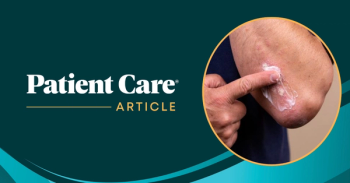
The AIDS Reader
- The AIDS Reader Vol 18 No 9
- Volume 18
- Issue 9
A Really Big Pain: Acute Epididymitis
A 24-year-old man with a history of HIV infection (CD4+ cell count, 746/µL [32%]; HIV RNA level, 980 copies/mL; nadir CD4+ cell count, 482/µL [29%]), secondary syphilis, major depression, and intermittent crystal methamphetamine use presented to the emergency department with a 1-week history of gradually increasing pain and swelling in the left side of his scrotum, 2 days of fever (temperature to 38.6°C [101.5°F]), and chills.
A 24-year-old man with a history of HIV infection (CD4+ cell count, 746/µL [32%]; HIV RNA level, 980 copies/mL; nadir CD4+ cell count, 482/µL [29%]), secondary syphilis, major depression, and intermittent crystal methamphetamine use presented to the emergency department with a 1-week history of gradually increasing pain and swelling in the left side of his scrotum, 2 days of fever (temperature to 38.6°C [101.5°F]), and chills. He noted a wet spot on his underwear the day before the swelling started but thought it was urine. He did not notice any penile discharge, frequent urination, or pain on urination. He reported multiple episodes of unprotected insertive anal intercourse over the past month associated with use of crystal methamphetamine. His only current medications were multivitamin tablets and citalopram.
The patient's temperature was 38.9°C (102.1°F); blood pressure, 124/76 mm Hg; pulse rate, 96 beats per minute; and respiration rate, 18 breaths per minute. Findings from his physical examination were notable for an enlarged left scrotum, with a tender left testicle and a markedly tender mass above the testicle. Laboratory test results were notable for an elevated white blood cell (WBC) count (18,200/µL), without band forms. A urine dipstick test result was negative for the presence of nitrites and leukocytes; urine microscopy showed 1 to 2 red blood cells and 0 to 1 WBCs per high-power field and very few bacterial organisms. A testicular ultrasonogram revealed bilaterally enlarged epididymal heads and bilaterally thickened left epididymal bodies (greater on the left than on the right), as well as complex fluid collections on both sides of the scrotum (greater on the left than on the right) suggestive of pyoceles.
Treatment with intravenous piperacillin/tazobactam and vancomycin was started. The patient was given oral ketorolac for pain; ice packs were placed around the scrotum, which was elevated. His fever resolved, and his pain decreased markedly within 24 hours. A urology consultant did not feel that surgical drainage was needed. The patient was given intramuscular ceftriaxone and oral doxycycline; vancomycin was discontinued. A urine culture showed no growth, and results of urine ligase chain reaction testing for Neisseria gonorrhoeae and Chlamydia trachomatis were negative. The patient went home on the third hospital day with instructions to complete a course of oral doxycycline and levofloxacin.
DEFINITION AND EPIDEMIOLOGY
Acute epididymitis is a syndrome characterized by pain, swelling, and inflammation of the epididymis of less than 6 weeks' duration. Its true incidence and prevalence in the general population are unknown, but it appears to occur with increased frequency among younger men (under the age of 40)1 and in men who engage in unprotected anal intercourse.2 Many cases of epididymitis are caused by C trachomatis and N gonorrhoeae. It is likely that there is a recent increase in cases of epididymitis that parallels the increase in reported cases of Chlamydia infection and gonorrhea in the United States (increases of 5.6% and 5.5%, respectively, from 2005 to 2006).3
Although there are no data regarding the incidence or prevalence of epididymitis among men living with HIV/AIDS, the populations in which there is an increased frequency of epididymitis are also populations with an increased frequency of HIV infection. In addition, for the cases linked to sexual transmission, inflammation from these nonulcerative sexually transmitted diseases (STDs) can increase the likelihood of transmitting the virus to others.4
ETIOLOGY
The cause of acute epididymitis can be infectious or noninfectious; most cases are infectious in origin. Although the pathophysiology is still unproven, the most commonly accepted hypothesis is retrograde flow of infected urine into the ejaculatory duct.5
For men 35 years or younger, the most frequent cause of infectious epididymitis is C trachomatis or N gonorrhoeae. Coliforms are the most common causes of epididymitis in men older than 35 years, with Escherichiacoli being the most frequently found organism. Cases in this older-age group are thought to be related to obstructive urinary tract disease. However, these enteric organisms are also a common cause of sexually transmitted epididymitis among men who engage in insertive anal intercourse. Other, rarer causative organisms include Brucella species, Salmonella species, Mycobacterium tuberculosis, Candida species, and Cytomegalovirus. The latter 3 organisms are more common in immunosuppressed HIV-positive patients.
Even rarer are the noninfectious causes of epididymitis. These include sarcoidosis, vasculitic diseases (eg, Behet disease), and use of amiodarone.
DIAGNOSIS
Epididymitis is generally diagnosed clinically in a patient with a swollen, tender epididymis. A medical history should include questions about systemic symptoms (fever, chills) and urinary symptoms (dysuria, urethral discharge, urinary frequency), and a thorough sexual history (unprotected sex, anal intercourse) should be obtained. Physical examination may reveal tender swelling in the epididymal tail in early cases; the body of the epididymis, testicle, and spermatic cord may also be enlarged and tender as the disease spreads.6
The most important differential diagnosis is testicular torsion, a condition that requires early surgical intervention to avoid testicular infarction. Torsion usually presents with pain of a more sudden onset and more rapid escalation. Suggestive findings on physical examination are a high transverse position of the involved testicle. Although ultrasonography is often considered to be necessary to distinguish torsion from other causes of an acute scrotum, this diagnosis is generally made correctly on clinical grounds.7
Microscopic examination of urine is the primary means for testing for epididymitis. As noted in the CDC 2006 guidelines for diagnosis and management of epididymitis,6 evaluation includes first-void urine testing by dipstick for leukocyte esterase and/or microscopy looking for 10 or more WBCs per high-power field. This testing primarily checks for the presence of coliform infection. In addition, in men with urethritis, a Gram stain of the urethral secretions should be done to check for 5 or more WBCs per oil immersion field. The diagnosis of gonococcal infection can be further established by finding intracellular gram-negative diplococci in the WBCs. Nucleic acid amplification testing of urine for C trachomatis and N gonorrhoeae should also be done; because of its higher sensitivity for detection of C trachomatis, this test is preferred to culture8 or other test methods.
Ultrasonography is commonly done. In addition to its ability to aid in the diagnosis of testicular torsion, it can also be useful in detecting abscesses. Although ultrasonography is considered mandatory by some,9 others question if it adds much to clinical diagnosis.7 An unpublished study shows no diagnostic advantage of the test in patients with a clear history of and examination findings consistent with epididymitis.10
TREATMENT
Most cases of epididymitis can be treated on an outpatient basis. Hospital admission should be considered for patients who have a toxic appearance; have significant systemic symptoms, such as fever, leukocytosis, or hypotension; have severe pain suggestive of other diagnoses; have significant comorbidities, such as severe immunosuppression or uncontrolled diabetes mellitus; or are likely nonadherent to outpatient antibiotic therapy.5,6 In the case presented, the patient's high fever and suspicion for abscess as noted by ultrasonography led to the decision to admit him to the hospital.
Therapy for epididymitis should be in accordance with established treatment guidelines.6 Nonspecific treatment for epididymitis includes bed rest, scrotal elevation, and NSAIDs and other analgesics as needed. Antibiotic therapy should be started empirically pending laboratory results. Given the significant number of cases caused by sexually transmitted organisms, treatment goals include prevention of transmission to others. For cases considered to be caused by gonococcal or chlamydial infections, treatment should include antibiotics that adequately treat both partners. Treatment with intramuscular ceftriaxone 250 mg as a single dose and doxycycline 100 mg orally twice daily for 10 days is currently recommended for both infections.
Because of widespread resistance of N gonorrhoeae to fluoroquinolones, this drug class is no longer recommended.11 If the cause is thought to be enteric organisms, the recommended treatment is either ofloxacin 300 mg orally twice daily for 10 days or levofloxacin 500 mg orally once daily for 10 days. If the cause is unclear, treatment regimens for both N gonorrhoeae and Chlamydia infections and infections with enteric organisms can be used, pending test results. Patients whose condition fails to improve after 3 days of antibiotic therapy should be reevaluated for other possible diagnoses.
Sex partners who had contact with the patient with epididymitis within the preceding 60 days should be referred for evaluation and treatment; patients and partners should avoid sexual intercourse until treatment is completed and they are asymptomatic. Safer sex counseling should be done in an effort to decrease the possibility of transmission and acquisition of STDs in the future. Attention should also be paid to substance abuse issues, especially crystal methamphetamine use, which is associated with increased unsafe sexual activity.12 In the case presented, the patient's crystal methamphetamine use was a trigger to much of his unprotected sexual activity. Need for abstinence and/or risk reduction should be discussed, with treatment referral as needed.
References:
References1. Mittemeyer BT, Lennox KW, Borski AA. Epididymitis: a review of 610 cases. J Urol. 1966;95:390-392.
2. Berger RE, Kessler D, Holmes KK. Etiology and manifestations of epididymitis in young men: correlations with sexual orientation. J Infect Dis. 1987;155:1341-1343.
3. Centers for Disease Control and Prevention. Trends in Reportable Sexually Transmitted Diseases in the United States, 2006. Atlanta: Centers for Disease Control and Prevention, Dept of Health and Human Services; November 2007.
4. Wasserheit JN. Epidemiological synergy: interrelationships between human immunodeficiency virus infection and other sexually transmitted diseases. Sex Transm Dis. 1992;19:61-77.
5. Tracy CR, Steers WD, Costabile R. Diagnosis and management of epididymitis. Urol Clin North Am. 2008;35:101-108, vii.
6. Centers for Disease Control and Prevention. Sexually transmitted diseases treatment guidelines, 2006. MMWR. 2006;55(RR-11):1-94.
7. Hendrikx AJ, Dang CL, Vroegindeweij D, Korte JH. B-mode and colour-flow duplex ultrasonography: a useful adjunct in diagnosing scrotal diseases? Br J Urol. 1997;79:58-65.
8. Swain GR, McDonald RA, Pfister JR, et al. Decision analysis: point-of-care Chlamydia testing vs laboratory-based methods. Clin Med Res. 2004;2:29-35.
9. Ludwig M. Diagnosis and therapy of acute prostatitis, epididymitis and orchitis. Andrologia. 2008;40:76-80.
10. Tracy CR, Costabile R. The use of color Doppler ultrasound (CDUS) in the evaluation and treatment of epididymitis in a university based health care system. 65th Annual Mid-Atlantic Section of the American Urological Association; October 18-21, 2007; Southampton, Bermuda. Abstract P14.
11. Centers for Disease Control and Prevention. Update to CDC’s sexually transmitted diseases treatment guidelines, 2006. MMWR. 2007;56:332-336.
12. Urbina A, Jones K. Crystal methamphetamine, its analogues, and HIV infection: medical and psychiatric aspects of a new epidemic. Clin Infect Dis. 2004; 38:890-894.
Articles in this issue
Newsletter
Enhance your clinical practice with the Patient Care newsletter, offering the latest evidence-based guidelines, diagnostic insights, and treatment strategies for primary care physicians.























































































































































































































































































































